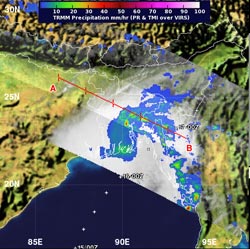NASA Sees Heavy Rainfall as Cyclone Mahasen Made Landfall

When NASA’s TRMM satellite passed over Cyclone Mahasen on May 16 at 0406 UTC (12:04 a.m. EDT), the TRMM Microwave imager showed the heaviest rainfall was occurring in a band of thunderstorms north of the center of circulation. That band of thunderstorms was already over southern Bangladesh and dropping as much as 2 inches/50 mm of rain per hour along the coast. Credit: NASA/SSAI, Hal Pierce <br>
When NASA’s Tropical Rainfall Measuring Mission (TRMM) satellite passed over Cyclone Mahasen on May 16 at 0406 UTC (12:04 a.m. EDT), the TRMM Microwave imager showed the heaviest rainfall was occurring in a band of thunderstorms north of the center of circulation. That band of thunderstorms was already over southern Bangladesh and dropping as much as 2 inches/50 mm of rain per hour along the coast. TRMM measured the highest cloud tops near 7.4 miles / 12 km high.
Mahasen made landfall northwest of Chittagong around 0600 UTC (2 a.m. EDT) on May 16, as a tropical storm with maximum sustained winds near 45 knots (51.7 mph/83.3 kph). Mahasen is moving further inland in a north-northeasterly direction at 22 knots (25.3 mph/45.7 kph). At 0900 UTC (5 a.m. EDT), Mahasen was located near 23.7 north and 91.7 east, about 53 nautical miles (61 miles/98.1 km)southeast of Dhaka, Bangladesh. Just 50 minutes after TRMM captured the rainfall rates within Mahasen, the MODIS instrument aboard NASA’s Aqua satellite captured a visible image of Cyclone Mahasen that showed the extent of its clouds over India, Bangladesh, and Burma.
As of 12:38 UTC (8:38 a.m. EDT), the Bangladesh Meteorological Department (BMD) maintained a Signal Number 3 warning for maritime ports of Chittagong, Cox's Bazar and Mongla. For a look at Bangladesh radar, visit the BMD web page: http://tinyurl.com/c5vbs35.
The interaction with the land is causing Mahasen to fall apart rapidly, according to forecasters at the Joint Typhoon Warning Center. The system became disorganized just hours after it made landfall.
Mahasen is forecast to track across northeastern India while weakening, especially as it tracks over rugged terrain. Mahasen is also expected to encounter strong wind shear which will help speed the weakening and drop it below tropical storm status later in the day.
Text Credit: Rob Gutro
NASA's Goddard Space Flight Center, Greenbelt, Md.
Media Contact
All latest news from the category: Earth Sciences
Earth Sciences (also referred to as Geosciences), which deals with basic issues surrounding our planet, plays a vital role in the area of energy and raw materials supply.
Earth Sciences comprises subjects such as geology, geography, geological informatics, paleontology, mineralogy, petrography, crystallography, geophysics, geodesy, glaciology, cartography, photogrammetry, meteorology and seismology, early-warning systems, earthquake research and polar research.
Newest articles

Superradiant atoms could push the boundaries of how precisely time can be measured
Superradiant atoms can help us measure time more precisely than ever. In a new study, researchers from the University of Copenhagen present a new method for measuring the time interval,…

Ion thermoelectric conversion devices for near room temperature
The electrode sheet of the thermoelectric device consists of ionic hydrogel, which is sandwiched between the electrodes to form, and the Prussian blue on the electrode undergoes a redox reaction…

Zap Energy achieves 37-million-degree temperatures in a compact device
New publication reports record electron temperatures for a small-scale, sheared-flow-stabilized Z-pinch fusion device. In the nine decades since humans first produced fusion reactions, only a few fusion technologies have demonstrated…





















